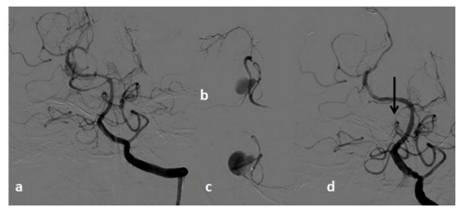Information
Journal Policies
A Rare Case of a Traumatic Pseudoaneurysm of the Superior Cerebellar Artery Treated by Embolisation with Nbca
Luis Suazo1,Hubiel Lopez2,Herwin Speckter3,Peter Stoeter4
2.Department of Radiology, Plaza de la Salud, Santo Domingo, Dominican Republic.
Copyright : © 2017 . This is an open access article distributed under the Creative Commons Attribution License, which permits unrestricted use, distribution, and reproduction in any medium, provided the original work is properly cited.
We report the rare case of a traumatic pseudoaneurysm of a branch of the superior cerebellar artery, which manifested itself by a subtentorial hemorrhage with a delay of three weeks after the trauma. The pseudoaneurysm was treated successfully by selective NBCA embolization including the occlusion of the parent artery. The intervention was tolerated well without further neurological deterioration. The case demonstrates that parent vessel occlusion is a valid treatment option in these rare pseudoaneurysms especially when the vascular territory supplied by this vessel has already been compromised before the intervention.
Posttraumatic pseudoaneurysm, superior cerebellar artery, subtentorial hemorrhage,Radiology and Medical Imaging
1. Background
Traumatic pseudoaneurysms of the superior cerebellar artery are rare findings. Since 1990, when Quatrocchi et al.[1] found just 3 cases in the literature, only few more cases have been reported [2-5]. Here we describe a traumatic pseudoaneurysm of the superior cerebellar artery in combination with an intracerebral bleeding due to a severe head trauma which was treated successfully by arterial glue embolization.
2. Case Presentation
The patient, a 26 year old male, was admitted to hospital after a severe head trauma, caused by a cutting knife on his left eye. He was admitted in Glasgow Coma Scale 13/15. CT showed skull base fractures, external pneumatocephalus, brain stem contusion and an intracerebral hemorrhage in the vermis and the right part of the pons (Figure.1). After 2 weeks, the patient had stabilized and could be extubated. After a further week however, he deteriorated due to a new bleeding at the same location, but with breaking into the ventricular system and progressive hydro cephalus, which needed shunting. Because of this second and “unexplained” hemorrhage, angiography was performed which showed an aneurysm arising from the parapontine segment of the vermian branch of the right superior cerebellar artery (Figure. 2). The distal localization of the aneurysm and the small caliber of the parent vessel did not allow coiling or stenting, and the aneurysm and parent artery were occluded by selective n-butyl-acrylate embolization. The outcome was stable, not showing any deterioration in his neurological status. Control CT scan showed no further brain stem damage or cerebellar infarct.
3. Discussion
Posttraumatic intracranial aneurysms, in which the adventitia is still preserved, and pseudoaneurysmas with a disruption of the complete vascular wall, usually affect the anterior circulation[6]. Treatment may be surgical or interventional by placement of stents or flow diverters, but coil packing of aneurysms above the carotid sinus may be difficult because of the absence of a vascular wall [7,8]. Although glue injection might result in parent vessel occlusion, it could be tolerated well in special conditions as in PICA aneurysms, if brainstem perforators are not involved[9].
Among all posttraumatic cerebral vascular injuries, formation of a superior cerebellar artery pseudoaneurysm is an especially rare complication of head trauma and may be caused by a laceration of the arterial wall caused by the free edge of the tentorium.[2] Delayed or recurrent posttraumatic hemorrhage in the upper parts of the cerebellum may be a diagnostic hint to perform angiography [1]. As in supratentorial and PICA pseudoaneurysms [10], treatment is indicated because a case of late catastrophic rupture has been reported [4].
5. Conclusion
The case demonstrates that in pseudoaneurysms of the superior cerebellar artery, interventional occlusion of the lesion and the parent vessel by injection of glue is a valid treatment option, especially when the vascular territory supplied by this vessel has already been compromised before the intervention.
References
- Quattrochi KB, Nielsen SL, Poirier V, Wagner FC Jr. Traumatic aneurysm of the superior cerebellar artery: case report and review of the literature. Neurosurgery. 1990; 27:476-479.
- Proust F, Callonec F, Bellow F, Laquerriere A, Hannequin D, Fréger P. Tentorial edge traumatic aneurysm of the superior cerebellar artery. Case report. J Neurosurg. 1997; 87:950-954.
- Altman DA, Hui FK, Tumialán LM, Cawley CM. Subintimal hemorrhage in an unruptured superior cerebellar artery aneurysm: prelude to rupture: case report. Neurosurgery. 2008; 63:E368-9; discussion E369. Doi :10.1227/01. NEU. 0000320423.40846. A1.
- Ong CK, Ong MT, Lam DV, Wenderoth JD. Catastrophic delayed rupture of a traumatic aneurysm of the distal superior cerebellar artery in a child. J Clin Neurosci. 2010; 17:515-517. doi:10.1016/j.jocn. 2009.06.041.
- Paiva WS, Andrade AF, StermanNeto H, de Amorim RL, Caldas JG, Teixeira MJ. Traumatic pseudoaneurysm of the superior cerebellar artery. J Trauma Acute Care Surg. 2012;72:E115.doi:10.1097/TA.0b013e31 8238bee5.
- Miley JT, Rodriguez GJ, Qureshi AI. Traumatic intracranial aneurysm formation following closed head injury. J Vasc Interv Neurol 2008; 1:79-82. PMCID: 3317295
- Moon TH, Kim SH, Lee JW, Huh SK. Clinical analysis of traumatic cerebral pseudo aneurysms Korean J Neurotrauma 2015; 11:124-130. Doi:org/10.13004/kjnt. 2015.11.2. 124
- Liu P, Yang M, Cai M, Qin J, Pan L. Traetment of pediatric traumatic intracranial pseudo aneurysm using endovascular covered stent: three case reports. World Neurosurg. 2016; 88:693.e1-6.doi:10.1016/wneu.2015. 12.037
- Kumar A, Ahuja CK, Khandelwal N, Mathuriya SN. Endovascular N-Butyl cyanoacrylate glue embolization of traumatic anterior cerebral artery pseudo-aneurysm. Neurol India 2012; 60:663-665. doi: 10.4103/ 0028-3886.105216
- Sedat J, Chau Y, Mahagne MH, Bourg V, Lonjon M, Paquis P. Dissection of the posteroinferior cerebellar artery: clinical characteristics and long-term follow-up in five cases. Cerebrovasc Dis. 2007; 24:183-190. doi: 10.1159/000104475






